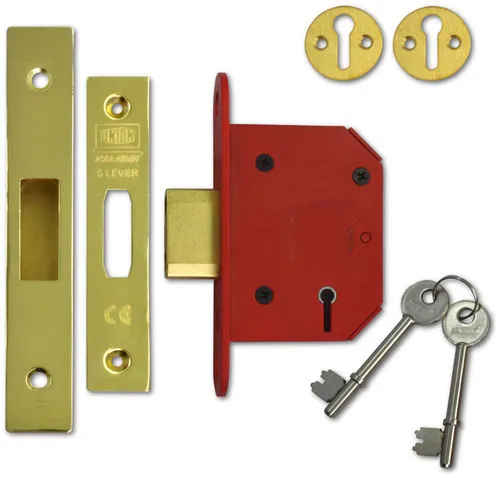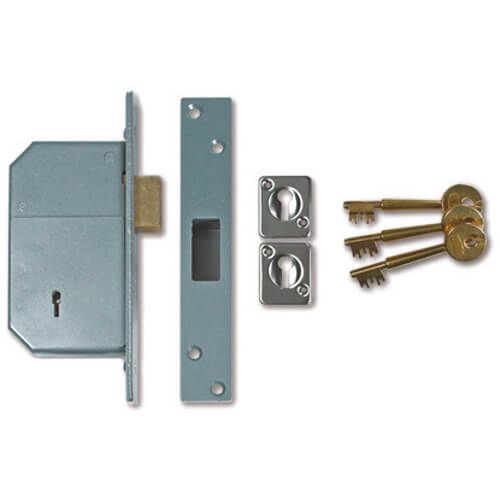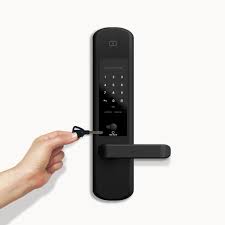Insurance Approved Door Locks

Home insurance companies approve certain types of locks for your house. These are the most To meet the requirements of British Standards (BS3621), ensure that your locks are secure. When acquiring home insurance, you'll need to specify the type of locks on your external doors and windows. If you provide incorrect information about the locks, it may result in problems if a claim is made. get burgled, your insurer could refuse to pay your claim.
So it’s really important to get them right - and we’ll help you work out which ones you have.
To ensure claim approval, check with your insurer for approved locks to use on your doors and windows. Incorrectly noting down the locks used can result in claim rejection. Premium costs can be reduced with the use of approved locks.
TYPES OF DOOR LOCKS
Most homes are secured by one or more of these types of locks
1. Five-lever mortice deadlock
The five-lever mortice deadlock is a popular lock type used in wooden doors. It can be locked and unlocked with a key from both inside and outside.
It operates by moving five levers into the correct position through the insertion and turning of the key. Due to its design, it is difficult to pick or drill, which makes it a preferred lock for many homeowners to meet home insurance security requirements.

How to identify a five-lever mortice lock
You can often identify a five-lever mortice deadlock by the following:
1. The lock's internal faceplate has the words '5 Lever' engraved on it.
2. These can only be installed on wooden doors and cannot be used on uPVC, aluminum, or composite doors.
3. This lock can be locked and unlocked using a key both from inside and outside. Language code for output: EN-US.
The lock is located inside the door frame.
How to tell if a five-lever mortice deadlock conforms to BS3621
A locking mechanism with a faceplate stamped with a British Standard Kitemark and the code BS3621 is an indication that it is approved by the BS3621.
The lock that has the BS3621 marking has undergone testing by the British Standards Institution (BSI Group) to ensure it can withstand common burglary methods such as lock picking and drilling.
If your mortice deadlock isn't BS3621 approved, your door may have a night latch fitted for added security.
2. Rim automatic deadlatch with key locking handles
The automatic deadlatch with key-locking handle is a type of door latch that can be locked and unlocked using a handle on the inside and a key on the outside.

Using it as the primary lock may lead to increased insurance costs since it is not the most secure option. However, it is commonly employed as an extra layer of security.
3. Key-operated multi-point locking system
When you turn the key, all the locking points of a multi-point locking system, which has a minimum of three locking points, will lock at the same time.
This type of lock is usually found on the patio or French doors, particularly those made of uPVC, rather than on your main entry door.
If your front door has a multi-point lock, your insurance provider will evaluate the level of risk and your insurance premiums may increase.
4. Euro cylinder locks
Euro cylinder locks, also known as pin tumbler locks, are a common lock type of lock fitted to the external front and back doors.
To unlock or lock the door, rotate the inner cam using the key, which will move the lock bolt.
Burglars can use a method called lock snapping to break into properties that have cylinder locks. Euro cylinder locks are more vulnerable to this method, which is why some insurers do not provide coverage for properties that have them.
5. Key-operated security bolts
Security bolts that can be controlled with a key are often used on wooden doors such as French or double doors. They are hidden inside the door's frame and can only be operated from the inside with a rack bolt key.
To add more security, your insurer may require you to install locks at both the top and bottom of your door.
.6. Padlocks
Shackle padlocks are commonly used to secure sheds, gates, and chains due to their simple installation and options for key or pincode access.
Generally, they provide minimal security as they can be easily broken with bolt cutters or saws.
TYPES OF PATIO DOOR LOCKS
Patio and French doors will usually be fitted with either a:
- Multi-point locking system
- The lock is operated by a key on either the top or bottom.
- The lock that operates with a key on the central rail is coded in English for the output language as EN-US.
The top or bottom lock will have the most basic level of security of the three. It’s usually used along with one of the other types of locks.
That should stop it from splitting if someone tries to break in by forcing the door.
ACCESSIBLE WINDOWS AND KEY-OPERATED LOCKS
For ground-floor windows, it may be necessary to have key-operated locks on all windows for insurance purposes and overall protection.
Windows that are considered accessible are those found on the ground floor or basement level, or ones that can be reached easily from the ground and have the ability to be opened. For instance, a first-floor window that is located above a single-story extension with a flat roof would also be considered accessible.
The statement applies to both skylights and roof lights
HOW MUCH DOES IT COST TO REPLACE A LOCK?
The Locksmiths Association stated the following costs for replacing or changing different types of locks in 2023: mortice, night latch, patio door, or uPVC.
- The of replacing a mortice lock will begin at £115, but if you only need the mortice itself and not the labour, it can start from as little as £20.
- To replace a night latch (Yale lock) on a wooden door, the prices begin at £90.Replacing a patio door lock starts from £90
- The cost of replacing a standard euro cylinder lock on a uPVC door is £85, while the cost of replacing it with an anti-snap euro cylinder on the same type of door is more expensive and starts from £110.
ADDITIONAL SECURITY
Consider installing a night latch on your doors to enhance security. Some home insurance providers offer discounts for this. However, before making the purchase, compare home insurance quotes and evaluate if the investment is worthwhile.
WHY ARE APPROVED LOCKS WORTH IT?
"Using approved locks can serve two great purposes: keeping burglars out of your home and qualifying you for lower home insurance premiums due to being classified as a lower risk."
According to our home insurance expert Steve Parkins, if you inform your insurer about having a burglar alarm or window locks, they would expect you to use them. Failing to use them or maintain the alarm might result in your insurer refusing to pay out in case of a break-in. This is why having these security measures will show that you have taken all possible steps to prevent a break-in.
WHAT LOCKS ARE BEST FOR YOUR HOUSE?
To determine the appropriate lock for your doors or windows, consider factors such as the type of doors or windows you have and your insurer's requirements. Additionally, consider your home's security needs.
